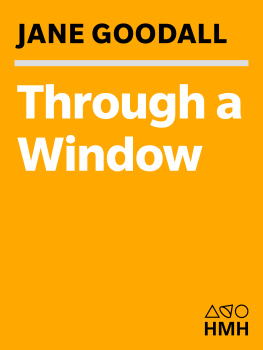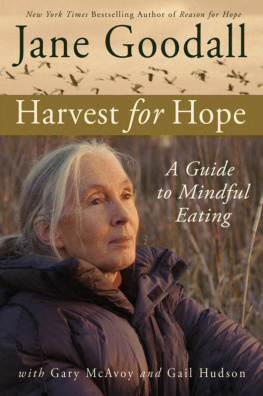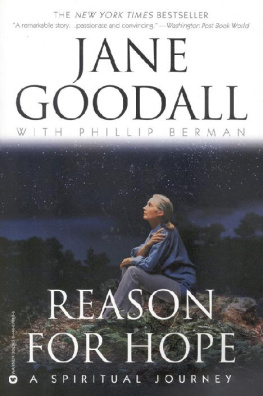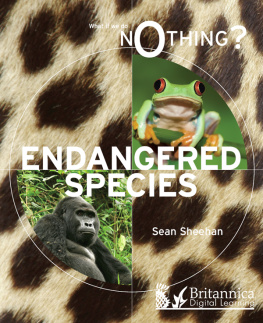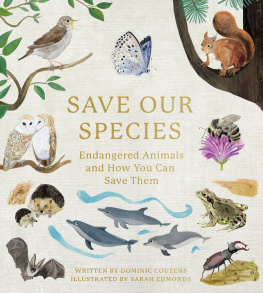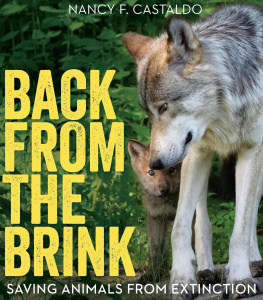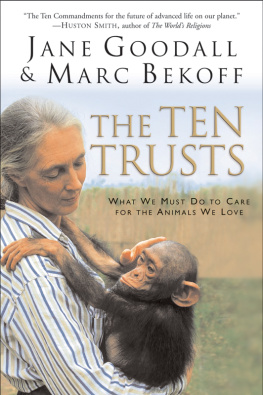Jane Goodall - Hope for Animals and Their World: How Endangered Species Are Being Rescued from the Brink
Here you can read online Jane Goodall - Hope for Animals and Their World: How Endangered Species Are Being Rescued from the Brink full text of the book (entire story) in english for free. Download pdf and epub, get meaning, cover and reviews about this ebook. year: 2009, publisher: Grand Central Publishing, genre: Science. Description of the work, (preface) as well as reviews are available. Best literature library LitArk.com created for fans of good reading and offers a wide selection of genres:
Romance novel
Science fiction
Adventure
Detective
Science
History
Home and family
Prose
Art
Politics
Computer
Non-fiction
Religion
Business
Children
Humor
Choose a favorite category and find really read worthwhile books. Enjoy immersion in the world of imagination, feel the emotions of the characters or learn something new for yourself, make an fascinating discovery.

- Book:Hope for Animals and Their World: How Endangered Species Are Being Rescued from the Brink
- Author:
- Publisher:Grand Central Publishing
- Genre:
- Year:2009
- Rating:4 / 5
- Favourites:Add to favourites
- Your mark:
- 80
- 1
- 2
- 3
- 4
- 5
Hope for Animals and Their World: How Endangered Species Are Being Rescued from the Brink: summary, description and annotation
We offer to read an annotation, description, summary or preface (depends on what the author of the book "Hope for Animals and Their World: How Endangered Species Are Being Rescued from the Brink" wrote himself). If you haven't found the necessary information about the book — write in the comments, we will try to find it.
Hope for Animals and Their World: How Endangered Species Are Being Rescued from the Brink — read online for free the complete book (whole text) full work
Below is the text of the book, divided by pages. System saving the place of the last page read, allows you to conveniently read the book "Hope for Animals and Their World: How Endangered Species Are Being Rescued from the Brink" online for free, without having to search again every time where you left off. Put a bookmark, and you can go to the page where you finished reading at any time.
Font size:
Interval:
Bookmark:
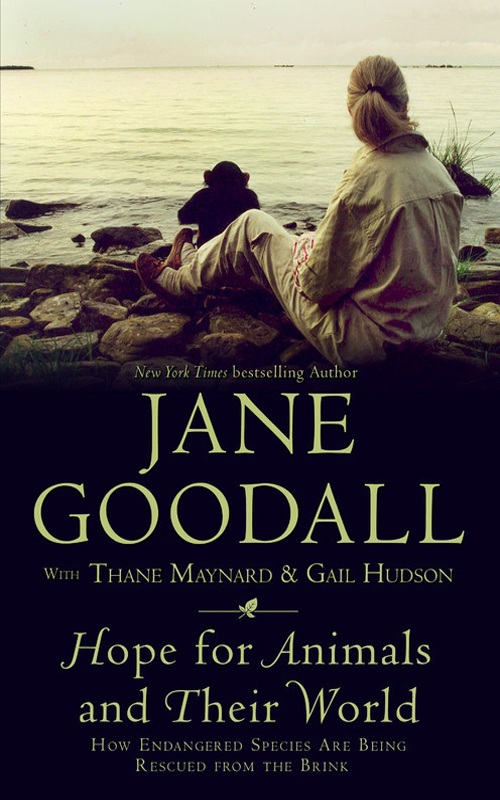
Copyright 2009 by Jane Goodall with Thane Maynard and Gail Hudson
All rights reserved. Except as permitted under the U.S. Copyright Act of 1976, no part of this publication may be reproduced, distributed, or transmitted in any form or by any means, or stored in a database or retrieval system, without the prior written permission of the publisher.
Grand Central Publishing
Hachette Book Group
237 Park Avenue
New York, NY 10017
Visit our website at www.HachetteBookGroup.com
www.twitter.com/grandcentralpub
First eBook Edition: September 2009
Grand Central Publishing is a division of Hachette Book Group, Inc.
The Grand Central Publishing name and logo is a trademark of Hachette Book Group, Inc.
Dr. Jane Goodall and the Institute do not endorse handling or interfering with wild chimpanzees. The chimpanzee in the jacket photo has been orphaned and lives at a sanctuary.
This book was printed on Domtars EarthChoice Tradebook. The paper contains fiber from well-managed environmentally sound forests that are independently certified to the standards of the Forest Stewardship Council. This paper also contains 25% recycled paper, which was recovered from post-consumer waste.
ISBN: 978-0-446-54338-5
This book is dedicated to the memory of Martha,
the last passenger pigeonand to the last Miss Waldrons
colobus and the last Yangtze River dolphin. As we think of
their lonely end, may we be inspired to work harder
to prevent others suffering a similar fate.
T his book was several years in the making, and it could not have been written without the help of many people. Indeed, one of the really great experiences for me during the past few years has been meeting so many extraordinary and dedicated scientists and conservationists. Between them they have accomplished so much, and I have been overwhelmed by their willingness to share their knowledge and to read, correct, and add to the accounts I had written about their projects. Such generosity. I cannot thank them enough.
While writing this book I learned about many wonderful projects from around the world. Unfortunately, when they were all written up, it was obvious that the manuscript was too long. Even when each story was cut, and cut again, the book was still too long. After much agonizing, it was decided that the only thing we could do was remove whole sections. I still feel devastated that this had to be done, mostly because the people whose projects I was writing about had spent so much time reading their chapters and ensuring that the information was correctand they were so pleased that the material would be included in the book. I know they will be disappointed and I feel terrible about it.
Our Web Site: However, there is a silver lining. The publishers have agreed to create a Web site that will feature all this material. It will also include the original versions of some chapters that were shortened for the book, as well as many photographs we gathered. I encourage everyone to visit the Web site and learn about the wonderful projects described there. You will also find my complete acknowledgments that had to be condensed for this book.
As I said, without the help and ongoing cooperation of the people profiled in these pages, this book would never have been possible. You will find their names and heroic stories in the chapters to come. I would also like to thank the following people, who helped us tremendously but whose names you wont find in the pages ahead: Mark Bain (short-nosed sturgeon), Ann M. Burke (whooping crane), Phil Bishop (Hamilton frog), Pat Bowles (Caspian horse), Jane Chandler (whooping crane), Glenn Fraser (woodhen), Rod Gritten (glutinous snail), Nancy Haley (short-nosed sturgeon), Kirk Hart (short-tailed albatross), Diane Hendry (red wolf), Dave Jarvis (pedder galaxias), Tom Koerner and Dan Miller (trumpeter swan), Bill Lautenbach (Sudbury, Ontario), Alfonso Aguirre Muoz (Guadalupe Island), Mark Stanley Price (Arabian oryx), Ken Reininger (nene), Ruth Shea (trumpeter swan), Amy Sprunger (moapa dace), John Thorbjarnarson (Chinese alligator), Mike Wallace (California condor), Jake Wickerham (pedder galaxias), and Stephen S. Young (Cao Hai Nature Reserve).
I am really grateful to Don Merton. He has helped us with so many chapters in this book: The utterly fascinating story of the kakapo, New Zealands large flightless parrot, will appear on our Web site. And I thank Nicholas Carlile for his enormous help in reviewing several of the stories in this book. His contribution to rescuing the Goulds petrel will also appear on our Web site.
The following people provided me with information about heroic efforts to save our endangered plant species: Peter Raven, Hugh Bollinger, Nick Johnson, Lourdes Lulu Rico Arce, Michael Park, Tim Rich, Bill Brumback, Jo Meyerkord, Kathryn Kennedy, and Robin Wall Kimmerer. You will find their stories and contributions on our Web site. In particular, Victoria Wilman and Robert Robichaux sent me so much helpful information, as did Paul Scannell and Andrew Pritchard, who also met with me in Australia.
Another whole section that we couldnt fit into the book but will appear on our Web site is about how the general public and our youth are helping to save endangered species. It describes fabulous stories of how an endangered species can halt developments: Greg Ballmer told me about the Delhi Sands flower-loving fly, and I learned about the Salt Creek tiger beetle from Stephen Spomer, Leon Higley, Mitch Paine, and Jessa Huebing-Reitinger. Matt and Ann Magoffin are helping to save the Chirakua leopard frog, and Meredith Dreifus and her family are helping the red-cockaded woodpecker. Information for the Roots & Shoots section was provided by Chase Pickering, Tony Liu, and Dan Fulton. I was also helped by Susan and Alexandra Morris and Tim Coonan, who have worked for many years to protect the Channel Island fox.
Thane Maynard: I was extremely fortunate to meet with and interview a wide and fiercely bright cast of characters in the process of developing this book. Each of these scientists and conservationists has stood in the gap when it mattered most for these species. I would like to acknowledge the following people who helped me gather my Field Notes but whose stories and names do not appear in these pages. All of these people and stories will be featured on our Web site: Wangari Mathaai and her staff from the Greenbelt Movement; Kent Vliet (the American alligator); Pete Dunne (bald eagle); Rick McIntyre (gray wolf); Clay Degayner (Key Largo woodrat); Ron Austing (Kirtlands warbler); Scott Eckert (leatherback sea turtle); Greg Neudecker (trumpeter swan); Geoff Hill (ivory-billed woodpecker); Roger Payne (Pacific gray whale); Greg Sherley (weta of New Zealand); and Michael Samways (South African dragonflies). Naturally I want to thank my wife, Kathleen, for all her help and support through the years I worked on this book. My thanks go as well to the remarkable staff at the Cincinnati Zoo & Botanical Garden, who earn their stripes inspiring every zoo visitor with wildlife every day.
Photography: All the photographs that you see in this book and on our Web site were donated to us by the photographers. We are deeply grateful to all of them for their generosity and support. You will find their names in the photo credits, alongside their photographs. In many cases the heroes we profiled assisted us in finding photographs, but we also want to thank and acknowledge the following people who helped us acquire photos: Shalese Murray, Andrew Bennet, JoGayle Howard, Gary Fry, Fr. Ed Udovic, C.M., James Popham, Ann Burke, Christina Anderson, Douglas W. Smith, Antonio Rivas, Christina Simmons, Caron Glover, Penny Haworth, Vanessa Dinning, Stephen Monet, Jesse Grantham, Liz Condie, David van Berkel, and Rob Robichaux.
Font size:
Interval:
Bookmark:
Similar books «Hope for Animals and Their World: How Endangered Species Are Being Rescued from the Brink»
Look at similar books to Hope for Animals and Their World: How Endangered Species Are Being Rescued from the Brink. We have selected literature similar in name and meaning in the hope of providing readers with more options to find new, interesting, not yet read works.
Discussion, reviews of the book Hope for Animals and Their World: How Endangered Species Are Being Rescued from the Brink and just readers' own opinions. Leave your comments, write what you think about the work, its meaning or the main characters. Specify what exactly you liked and what you didn't like, and why you think so.

